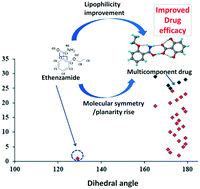Solubility and in vitro drug permeation behavior of ethenzamide cocrystals regulated in physiological pH environments†
Abstract
Diffusivity of a drug across biological membranes can arise not only due to membrane-based efflux mechanisms, but also due to a number of structural and interactive features. We prepared several cocrystals consisting of a BCS class-II drug, ethenzamide, combined with gentisic acid, γ-resorcylic acid, protocatechuic acid or α-resorcylic acid, and investigated the drug⋯coformer and solute⋯solvent non-covalent interactions, which can play significant roles in understanding drug solubility and permeation behavior. The solubility and membrane diffusion behavior through a cellulose membrane were determined in different physiological pH environments, and enhanced drug absorption, release and distribution was observed in vitro. The change in the lipophilic nature manifested by the conformational adjustment of the parent drug has established a link to explain the enhanced properties that are described herein. Further, this study sheds light upon the trade-off action between solubility and diffusivity, which is crucial for the advancement of pharmaceutical science.



 Please wait while we load your content...
Please wait while we load your content...